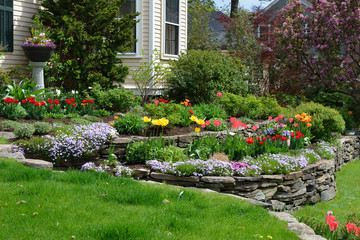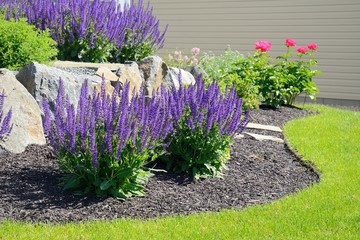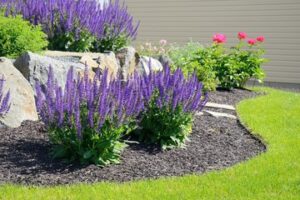Landscape Design Wellington involves creating functional and aesthetically pleasing outdoor spaces. It includes a combination of elements, including color, texture and form.
Continuity is achieved through interconnection of different garden features. A simple example of this is repetition of material, such as grasses repeated throughout a garden or lawn panel. Gradation can also be used by slightly varying the size, height or texture of materials to create interest.
In landscape design, utilizing principles of design provides structure to the overall layout of your yard. These include simplicity, variety, balance/repetition, emphasis/focalization, sequence/order, scale/proportion, and unity/consistency. The application of these principles will help you craft a cohesive, harmonious layout that will be visually appealing and functional.
The use of these seven essential concepts will help guide your design decisions throughout the process of creating a unique landscape that suits your needs. Each of these guiding concepts has an effect on the overall appearance and function of the garden or outdoor space, so it’s important to understand them before putting them into practice.
Lines in the landscape can create a sense of movement, both visual and physical, by drawing the eye through the space. For example, vertical elements such as tall trees or shrubs can draw the eye upward, while curved lines of walkways and planting beds can lead your eyes downward. Lines can also connect spaces through the use of a path or by connecting two focal points with a linear element, such as a water feature or bench.
Rhythm is created through the repetition of form, line, texture, and color in your landscape. This gives the design a flow and cadence, but it’s important to balance it with variety to avoid monotony. For example, a wide range of plant materials with different textures and colors can add interest to the design but it should be balanced with similar, more neutral elements for harmony.
Scale and proportion are also a guiding principle in designing your landscape, as it is important to ensure that your elements are in proportion with each other and the space. Using a ratio such as the rule of thirds can help you achieve proportional balance when choosing plants and objects for your space.
Emphasis is another key concept in landscape design, as it helps to delineate and direct the attention of the viewer through the use of contrasting shapes and colors. It can also be achieved through the hierarchy of space, where a particular area or element is given more visual weight than others to create a feeling of importance.
Elements of Design
Landscape design uses lines, shape, texture, color and space to transform an outdoor area. Much like an artist composes a painting, these elements work together to guide the eye around the landscape in a balanced and intentional manner. The elements and principles also help connect spaces visually and physically with the use of lines, emphasis or focal points, and repetition.
Line is the most basic of the design elements, defining a space and creating movement. Straight lines feel formal and direct, while curved lines evoke more organic feelings. When shaped into beds and walkways, or in hardscape features such as fences, a well-considered use of line can create balance and unity in the landscape.
Form describes the shape of your plants and structures, and is important to the overall balance of a landscape. Rectilinear forms like slender trees, squared or rectangular stone pavers, and angular hardscape objects delineate the edges of planting areas and create a sense of structure. Circular shapes and irregular forms, such as rounded shrubs, mounding perennials and flowing waterfalls add interest and contrast to a landscape.
The amount of space occupied by an object is referred to as mass in the landscape, and it also plays a role in the flow and connectivity of the landscape. Open areas of turf or other natural vegetation, and the size of plant and hardscape masses, are all important in determining the scale of the landscape. Mass can also evoke emotions in the visitor. Large, imposing tree forms feel strong and dominant, while small, delicate flower masses feel feminine and soft.
Color adds life and energy to the landscape, attracting attention and helping define spaces. Whether through pavers for the patio, a stone retaining wall, the flowers selected, or the water feature, the use of color helps to unify the landscape and create a cohesive, harmonious design.
Focal points capture the eye and draw visitors into a landscape, drawing them toward features such as specimen trees, water features, or unique sculptures. Emphasis is also achieved through the use of lines to direct the eye to a particular area or element, and through the placement of various plants throughout the landscape.
Lines in Design
The line is one of the simplest elements in landscape design and is used to add structure, frame a view and guide movement. It can be straight, curved, horizontal or diagonal. The choice of line and how it’s used can create a very different look. For example, straight lines with hard angles will give your design a very formal appearance while a curved line will provide a more informal feel.
Whether they’re created by plant material, walkways or the boundaries of a patio or deck, all lines in a landscape project are important. Using a variety of line shapes and types is what makes a landscape design interesting and unique, while also creating balance.
In the garden, vertical lines tend to move the eye upward, making an area feel larger. Arbors, tall plants and trellises are all great examples of vertical elements. Horizontal lines pull the eye along the ground plane, and they can be used to both tie areas together or separate them. Walkways, low garden walls and short hedges are all good examples of horizontal lines.
When a landscape contains a combination of straight and curved lines, the result is movement that’s calming to our souls. It’s a design principle known as the “golden ratio,” and it can be found everywhere in nature – flower petals, hurricanes, animal bodies and even DNA molecules!
As you’re likely aware, color has a significant impact on the way we perceive a landscape. The use of cool tones in a garden can be relaxing while warm tones make an area seem powerful and inviting.
Rhythm and repetition are the other key principles of landscape design. The repeated use of plant materials, lamp posts, benches or other structures is what creates the sense of flow and movement in a landscape. You may notice this in the layout of your flower beds, sidewalks, where turf meets pavement and other hardscaping features.
Unity
Landscape design involves a variety of different skills and disciplines to create beautiful, functional outdoor spaces. These are designed for residential, commercial and public use and may include plants and hardscapes such as walkways and patios. Landscape designers must be knowledgeable about a wide range of subjects, including architecture, horticulture and ecology.
A good landscape design will incorporate the elements of unity, balance and proportion. These are used to achieve a harmonious composition and ensure that all the parts of the landscape fit together in a natural way. Unity is achieved through features that are repeated throughout the design, such as a focal point, lines, textures and color. The varying heights of plant and hardscape features is another element that can be used to achieve unity.
Balance is achieved through a variety of different techniques, including scale and proportion. The various components should be in proportion to each other and shouldn’t dominate the space. For example, a small garden shouldn’t be dwarfed by a large house. The scale of a garden can also be balanced by using contrasting colors and shapes.
The most important element of landscape design is the relationship between human activities and the ecological system. In order to preserve the environmental integrity of a landscape, the designer must make sure that any changes are minimal and do not disrupt existing ecosystems. In addition, the designer must consider the ecological benefits of landscapes, such as their positive impact on the health and mood of people who are exposed to them.
While most homeowners will not need to hire a professional landscape designer, it is still helpful for them to understand some basic principles of design. This will help them plan their own gardens, and will save them money by avoiding costly mistakes and unnecessary expense.
A well-designed yard will add to the beauty and value of a home. In fact, studies have shown that well-designed landscaping can increase a home’s value by up to twenty percent. However, it is important for homeowners to realize that a professionally designed yard requires careful planning and execution. A landscape that is haphazardly planted can be both a nuisance and a liability, and may not provide the desired aesthetic or function.


